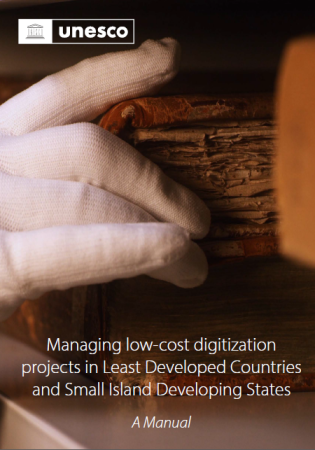ACTIONS
- Protect and safeguard cultural and natural heritage
- Learning and educational opportunities
- Cultural participation/social inclusion
- Sustainable tourism
- Support research
- Employment (recruiting, training, safety)
- Energy consumption, greenhouse gas emissions
- Waste management and reduction
- Transport (forms of, energy use)
- Commercial activities including copyright and IP
- Governance and management
- Security, disaster preparedness, risk reduction
- External partnerships and collaborations
- Toolkit/framework/roadmap
Managing Low-cost Digitization Projects in Least Developed Countries and Small Island Developing States - A Manual

Intended Audience
Museum, library, archive, gallery staff and professionals who manage documentary heritage in Least Developed Countries (LDCs) and Small Island Developing States (SIDS)
- United Nations Educational, Scientific and Cultural Organization (UNESCO)
“A key issue is the inability – often associated with budgetary constraints – to undertake large-scale digitization projects which can enable their libraries, archives, museums and other holding places to continue providing services in health emergencies that require little or no physical movement by the provider and the user. This publication fills this gap by i) providing such memory institutions with state-of-the-art technical information on how to manage low-cost digitization projects; and ii) highlighting existing resource opportunities and partnerships for such digitization projects.”
Avaiable in
- English
Actions
- Protect and safeguard cultural and natural heritage
- Learning and educational opportunities
- Cultural participation/social inclusion
- Support research
- Employment (recruiting, training, safety)
- Commercial activities including copyright and IP
- Governance and management
- Security, disaster preparedness, risk reduction
- External partnerships and collaborations
SDGs LINKAGES
This open-access resource helps its target audience to address several SDG targets, including 4.A (inclusive and effective learning environment for all), 9.5 (enhanced facilities and technological upgrades for researchers), 11.4 (strengthen efforts to protect various forms of documentary heritage), 16.10 (public access to information and digitized collections), 17.8 (increase innovation capacity), and 17.9 (enhance international support for developing countries).
Click on the SDG Target to discover Our Collections Matter indicators
-
Our Collections Matter indicators:
- Number and proportion of education facilities that are child, disability and gender sensitive.
- Proportion of education facilities that provide safe, non-violent, inclusive and effective learning environments for all.
- Number and type of initiatives to improve effectiveness of learning environments.
- Support given to other education facilities to make them more inclusive and effective.
-
Our Collections Matter indicators:
- Number and proportion of collections facilities that effectively support research and researchers.
- Number and proportion of staff who are appropriately skilled to undertake and support collections-based research.
- Expenditure on initiatives to enhance and upgrade collections facilities.
- Numbers of staff engaged in supporting and developing research use based on collections.
- Number of initiatives to encourage innovation drawing on collections.
- Increase in number of research and development workers per 1 million people.
- Increase in public and private research and development spending being used to develop and make use of collections.
-
Our Collections Matter indicators:
- Total expenditure (public and private) per capita spent on the preservation, protection and conservation of all cultural and natural heritage, by type of heritage.
- Plans, policies and procedures in place for the safe use of collections for a variety of purposes, protecting and safeguarding both collections and those who use them.
- Plans, policies and procedures in place for the identification, safeguarding and protection of cultural and natural heritage at risk.
- Collecting programmes in place to protect, safeguard and make use of cultural and natural heritage, addressing the needs of communities and stakeholders, and ensuring that collections can be an effective resource for sustainable development.
- Number and diversity of educational, awareness-raising, research programmes, and partnerships that aim to strengthen protection of cultural and natural heritage.
-
Our Collections Matter indicators:
- Adopt and implement constitutional, statutory and/or policy guarantees for public access to information.
- Plans in place, and plans implemented to enhance public access to information relating to collections.
- Plans in place, and plans implemented to support fundamental freedoms, in line with human rights, national and international agreements and legislation.
- Plans and procedures in place for public access to information relating to the operation and management of collections-based institutions.
- Complaint mechanism in place for public to use where public access to information and fundamental freedoms not supported or fulfilled.
-
Our Collections Matter indicators:
- Number and diversity of international capacity-building activities to aid implementation of each and all of the SDGs.
- Number and diversity of North-South, South-South, and/or triangular co-operations and partnerships to aid implementation of each and all of the SDGs.
-
Our Collections Matter indicators:
- International financial and other forms of support for science, technology and innovation in least-developed countries, notably from Global North countries, and in relation to information and communications technology.
